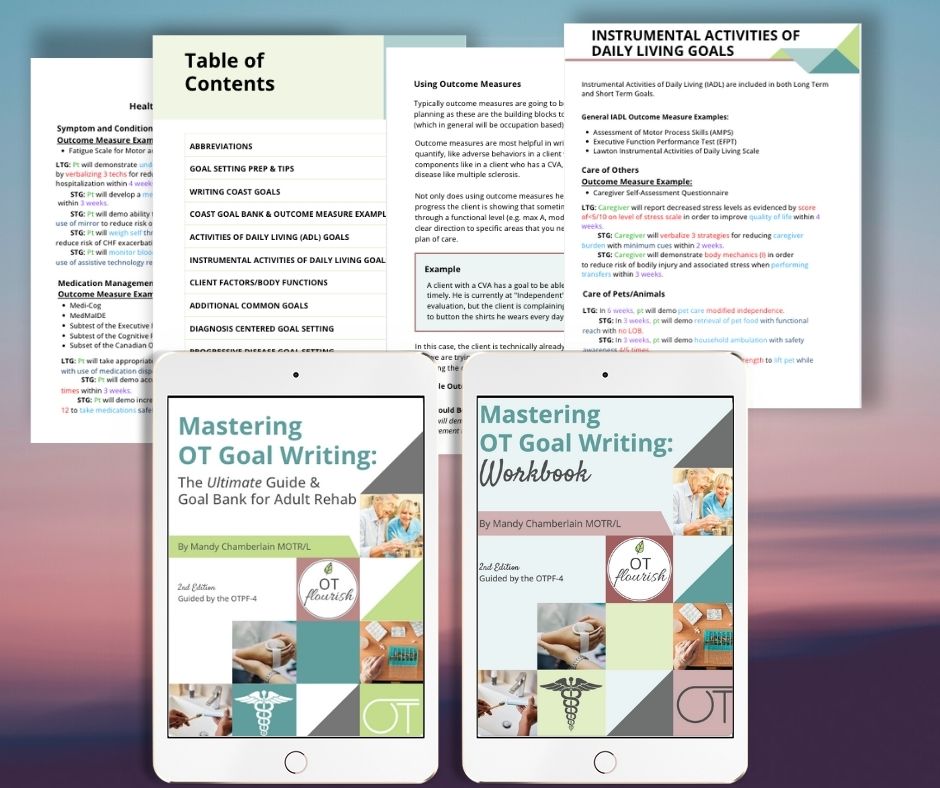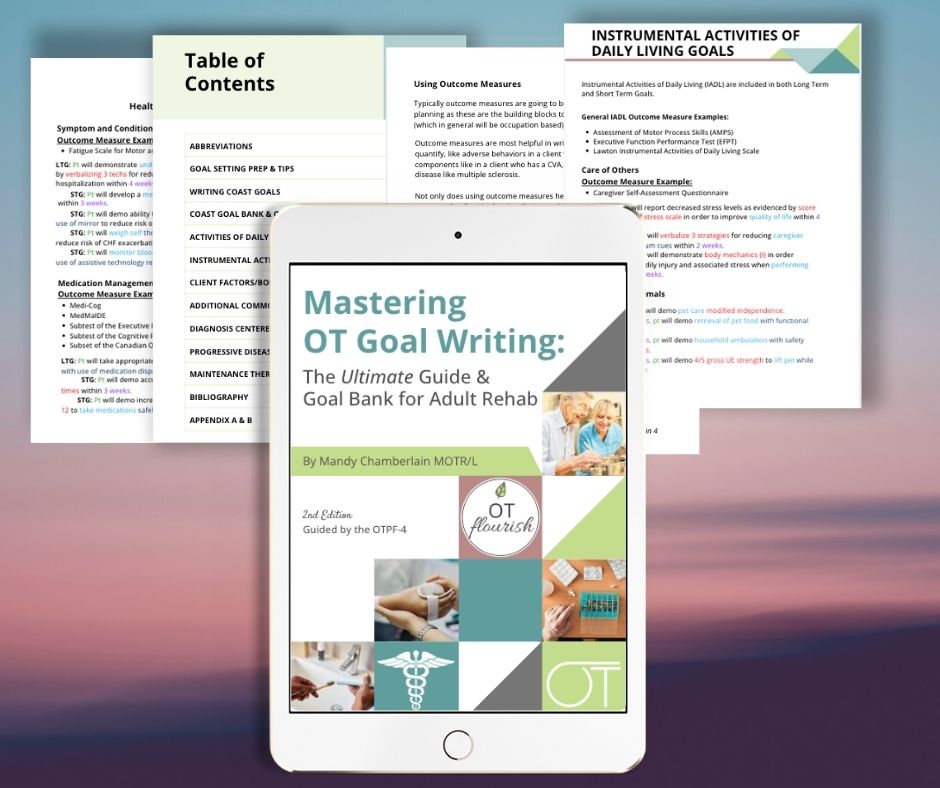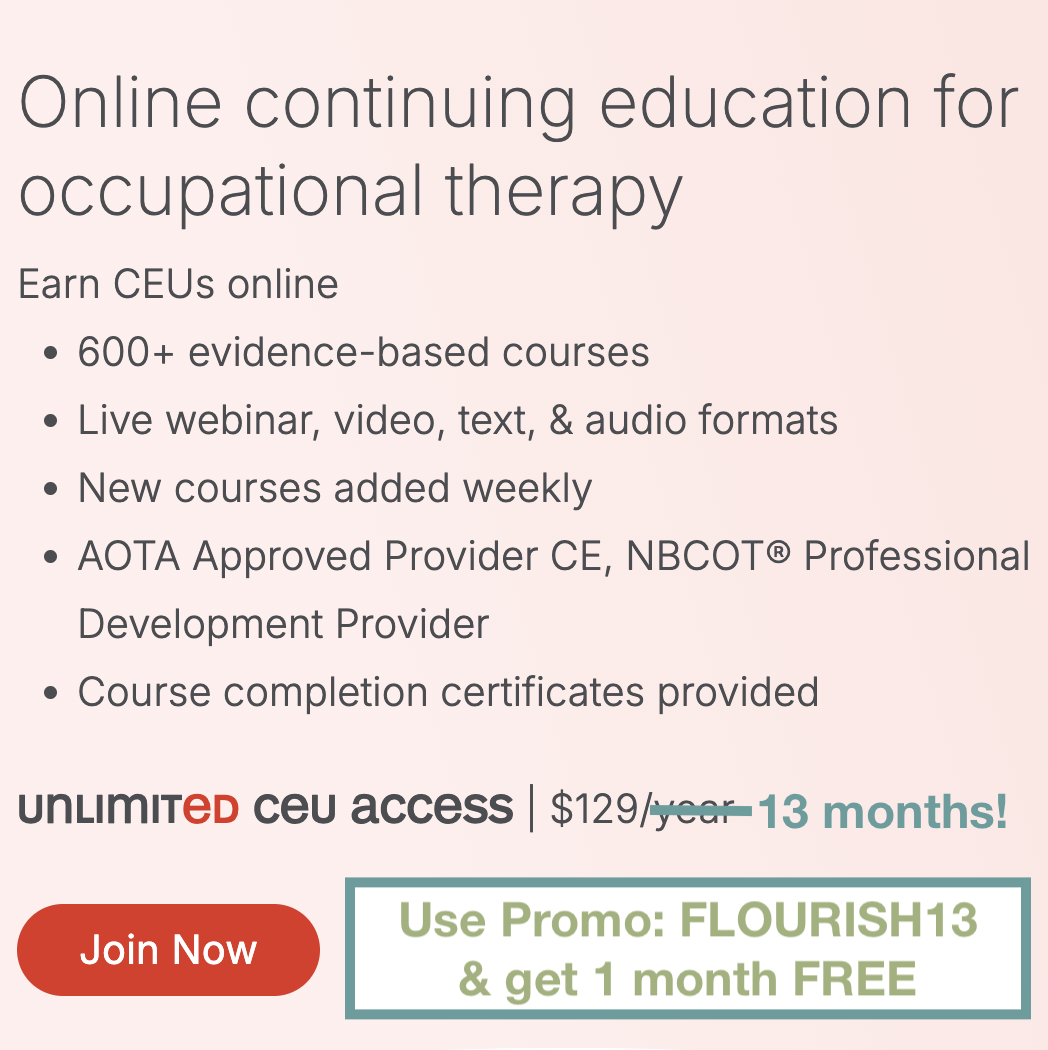We have all been there, trying to figure out what is the best and easiest way to make OT goal writing successful, but why is this sometimes so hard?
UGH 😫
See, I was randomly looking through the Occupational Therapy Treatment Ideas & Information Facebook page the other day (it is a HUGE group with tons of ideas!), when I came across a post about an OT that was talking about how difficult it was for her to write goals beyond the typical ADL.

So I wanted dig in and explore what are some of the most common reasons that OT goal writing is such a pain in the butt, what we need to do in order to make our OT goals more skilled, collaborative and client centered, and share some of my favorite resources (including the Mastering OT Goal Writing: The Ultimate Guide & Goal Bank for Adult Rehab ebook – a complete must have to write rock solid, client-centered OT goals, check it out below ).
Let’s Dig Into Why Writing Goals Can Be Challenging:
Problem 1: We are limited by the electronic medical record we use.

Let’s be honest, we are at the mercy of the software that we are given!
It is hard when all you are doing is trying to write goals based on the information that you have collected during your evaluation, but all you end up doing is navigating through endless dropdowns and trying to “fit” your patient into the software.
It’s a balance between trying to create OT goals that are client centered, are relevant to the clients self directed goals, goals based on what insurance will pay for and what we see as occupational therapists that need to be addressed in order to accomplish all of this! 😱

Problem 2: There are many different ways to actually accomplish goals.
It seems like every OT setting, facility and school has a different way of teaching this, with some of the most common being:
- COAST (my all time fav!): Client, Occupation, Assist level, Specific, Time bound

- OT SMART Goals: Significant, Measurable, Achievable, Relates to person, Time based
- RHUMBA: Relevant, How long, Understandable, Measurable, Behavioral, Achievable
Problem 3: We aren’t always taught (or maybe it just gets lost over time) to use outcome measures or use our initial evaluations to guide our goals.
We end up writing OT goals that are:
- not the most client-centered,
- hard to achieve,
- using too many measurements to make the goal difficult to achieve or
- labeled as “not functional.”
What is an example of a written goal?
“NEEDS SOME IMPROVEMENT” OT GOAL WRITING:
Within 2 weeks, the patient will perform upper body dressing (UB) independently (I) with use of adaptive equipment (AE) while sitting edge of bed (EOB) with “good” dynamic sitting balance.
Because this OT goal writing example has so many conditions, it will be very difficult for the patient to actually meet all of these conditions and look like they are progressing, even if they technically are. Maybe the patient does perform UB dressing with a piece of adaptive equipment independently (which would actually be modified independent, not independent) sitting at the edge of the bed, but with only fair+ balance. They would not meet the goal.
Break it down!
“DEFINITELY CLEAR AND TO THE POINT” OT GOAL WRITING:
Within 2 weeks, the patient will perform UB dressing (I) with “good” dynamic sitting balance.
This OT goal writing example has each part of a COAST goal (Client, Occupation, Assist level, Specific, Time bound), which makes it not only makes it clear what the patient needs to work on, what occupation is being addressed, how much assistance is expected, and how long it will take for the patient to actually achieve this goal.
What are good occupational therapy goals?
Occupational therapy is a profession focusing on helping a client perform the occupations they need and want to do. OT goal writing should be collaborative, client-centered and follow one of the recommended goal formats, such as the COAST method.
Some things to keep in mind are:
#1: Use outcome measures in your goals, especially in short term goals or goals that are difficult to quantify or measure
It’s really important to include outcome measures when setting goals, especially short term goals, and there are some great reasons for that. These measures give us a standard and objective way to see how our clients are progressing and whether the interventions we’re using are effective. They become especially handy when we’re dealing with objectives that aren’t easy to measure directly.
For instance, if a client’s short-term goal is to improve their hand function after a stroke, we can use a tool like the Jebsen-Taylor Hand Function Test. This test breaks down hand functions into specific actions, like picking up small objects or page turning. By doing this, we establish a clear starting point and can precisely track how our client is progressing towards their goal.
Likewise, when we’re working on more subjective goals, like boosting a client’s self-confidence, etc in daily activities so they can participate in them regularly, we can turn to standardized self-report scales such as the Occupational Self-Assessment (OSA).
These scales allow us to measure changes over time objectively. Plus, they contribute to the entire goal-setting process by making sure that our goals are not just realistic but also achievable. So, by using outcome measures, we’re not only helping our clients but also making our approach to goal-setting more effective and evidence-based.
#2: Get a good understanding of what should actually be in a Long Term and Short Term Goals
Let’s dive into the importance of distinguishing between long-term and short-term goals in our work in occupational therapy. This distinction is a key factor in crafting effective goals. Long-term goals typically encompass the broader objectives that our clients strive to achieve over an extended period, often representing the ultimate outcome of their therapy aka occupations.
These goals are ambitious yet attainable and serve as a guiding light throughout the entire treatment process, offering a clear sense of direction.
Long term goal example breakdown:
Let’s consider a client who’s recovering from a stroke. Their long-term goal might be something like “to be able to use the toilet on my own.” This goal is comprehensive and can involve various areas of intervention to help the client achieve it successfully.
Short term goal example breakdown:
Conversely, short-term goals are the smaller, specific steps or milestones that contribute to the realization of long-term (many times occupation focused) objectives. Think of them as building blocks – when accomplished sequentially, they lead to the fulfillment of the overarching goals. Building on our example, a short-term goal for this client could be focusing on increasing internal rotation so they are able to reach the back of their pants so they can accomplish the long term goal of toileting. This short-term goal is specific, measurable, and directly contributes to the long-term objective of independent living.
Understanding this dynamic between long-term and short-term goals is essential for us as therapists. It enables us to plan interventions effectively, keep a close eye on progress, and, importantly, maintain our clients’ motivation throughout their therapy journey. By recognizing the interplay between these goals, we can provide more client-centered, collaborative and efficient care.
#3: Do not write goals on occupations or components that are not a part of your evaluation
You need to set goals that truly align with our clients’ needs and goals.
It’s not just important; it’s vital.
When we’re in the process of crafting occupational therapy goals, it’s absolutely crucial to ground them in the comprehensive evaluation findings. We’re essentially building our goals on the foundation of what we’ve discovered during this assessment. This foundation should be the client’s specific needs and functional limitations that we’ve identified through the evaluation process.
It’s like creating a roadmap that leads us to meaningful outcomes!
By sticking closely to the needs we’ve assessed and concentrating on the relevant aspects of our clients’ daily life, we ensure that the goals we set are genuinely meaningful and purposeful. We can add goals as we work with a client, as actually assessing what the patient will be working on is vital to complete an activity analysis and get a clear understanding of what the patient specifically needs to work on in order to achieve their goals!
How can I get better at OT goal writing and get a goal bank guide for adults?
Be sure to check out the Mastering OT Goal Writing: The Ultimate Guide & Goal Bank for Adult Rehab ebook and Workbook It gives practical tips and instruction for goal writing in an easy to follow format, provides outcome measure examples for a variety of goals plus a bank of short term goals and long term goal examples for performance components and diagnoses. The goal writing workbook for adults gives examples and guides you through each step to practice OT goal writing.
Ready to write OT goals that ditches the cookie cutter method and directs your plan of care?
This comprehensive guide simplifies the goal-writing process for occupational therapy practitioners working in adult-focused settings. Inside, you’ll find:
- A structured, easy-to-follow goal-writing format
- Practical tips to ensure goals are measurable, attainable, and client-centered
- Outcome measure examples for a variety of goals
- A goal bank with both short-term and long-term goal examples for a variety of areas in the OTPF-4
- BADL
- IADL
- Body functions and client factors of occupational therapy practice
- Specialized areas such as:
- chronic conditions
- dementia
- low vision
- maintenance therapy
- progressive diseases and more!
Common Challenges in OT Goal Writing and How to Overcome Them
As occupational therapists, we are tasked with creating meaningful, measurable goals that truly reflect our client’s needs. However, there are several challenges that can make this process seem daunting. Let’s look at some common struggles OT practitioners face in goal writing and explore ways to overcome them.
Challenge 1: Lack of Clarity in Client Needs
One of the most common issues in goal writing is a lack of clarity when identifying a client’s specific needs. This can happen when there’s insufficient information gathered during the evaluation, or when clients aren’t able to clearly articulate what they want to work on.
Solution: To avoid this, we need to focus on thorough activity analysis and using outcome measures (if helpful for clarification and quantification) during the evaluation phase. Spend time asking clients about their daily routines, personal goals, and obstacles they face. Encourage them to be specific about what they want to improve and prioritize goals that align with their personal values. When a goal is client-driven, it naturally becomes more meaningful and achievable.
Challenge 2: Overcomplicating Goals
Another obstacle is the tendency to create overly complicated goals that are difficult to track. Sometimes, as we try to cover all aspects of a client’s progress, we end up creating a goal that includes too many details or multiple tasks that the client might not be ready to achieve all at once.
Solution: Stick to one primary focus for each goal. If you find that a goal has too many layers, break it down into smaller, more manageable steps. For example, if your client is working on increasing hand function, don’t combine it with multiple other objectives like improving fine motor skills and increasing endurance. Focus on one and then build from there.
Challenge 3: Insufficient Focus on Functional Performance
A challenge that many OTs face is writing goals that are not directly related to occupation. Sometimes, goals are written in a way that feels disconnected from a client’s ability to perform meaningful tasks in their daily life.
Solution: Always tie goals back to the occupations your client cares about. Instead of focusing on the abstract concept of improving “strength,” focus on how increasing strength will help your client accomplish a specific task, such as lifting a cup to their mouth independently. By making the goals task-oriented and occupation-centered, you’ll be more likely to see meaningful outcomes.
Challenge 4: Balancing Realism with Client Motivation
Another challenge is balancing the need for realistic goals with the desire to keep clients motivated. It can be tempting to set ambitious goals to inspire clients, but this can sometimes lead to frustration if the goal is too difficult to achieve in the set timeframe.
Solution: To avoid this, use the COAST goal framework and ensure that your goals are achievable yet challenging. Start by setting short-term goals that lead toward a larger, long-term objective. Keep the goals realistic, but encourage clients by showing progress along the way, which will help maintain their motivation.
Challenge 5: Managing Multiple Stakeholders’ Expectations
In some settings, goals must meet the expectations of not just the client, but also the family, medical team, and insurance providers. Each of these stakeholders might have different priorities, which can make it tricky to create goals that satisfy everyone.
Solution: Use a collaborative approach when setting goals. Include the client and their family in the goal-setting process and encourage open communication with other team members. Make sure that the goals align with the client’s values but are also occupational and functional from a medical standpoint. By discussing and aligning expectations early on, you can set realistic and client-centered goals that everyone can support.
Final Thoughts on OT Goal Writing
Mastering the art of OT goal writing takes practice, patience, and a deep understanding of your client’s needs. By focusing on clarity, occupational performance, realistic expectations, and client collaboration, we can create goals that truly empower our clients and guide our interventions in a meaningful way.
Remember, OT goal writing isn’t just about ticking boxes for compliance—it’s about setting a clear roadmap for client success. Whether you’re just starting your career or are a seasoned professional, keep refining your process, and don’t hesitate to use helpful resources like Mastering OT Goal Writing: The Ultimate Guide & Goal Bank for Adult Rehab ebook to stay on track.







